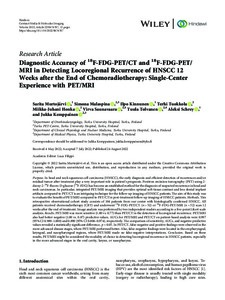Diagnostic Accuracy of F-18-FDG-PET/CT and F-18-FDG-PET/MRI in Detecting Locoregional Recurrence of HNSCC 12 Weeks after the End of Chemoradiotherapy: Single-Center Experience with PET/MRI
Murtojärvi Sarita; Malaspina Simona; Kinnunen Ilpo; Tuokkola Terhi; Honka Miikka-Juhani; Saunavaara Virva; Tolvanen Tuula; Schrey Aleksi; Kemppainen Jukka
https://urn.fi/URN:NBN:fi-fe2022102463038
Tiivistelmä
Purpose
In head and neck squamous cell carcinoma (HNSCC), the early diagnosis and efficient detection of recurrences and/or residual tumor after treatment play a very important role in patient's prognosis. Positron emission tomography (PET) using 2-deoxy-2-F-18-fluoro-D-glucose (F-18-FDG) has become an established method for the diagnosis of suspected recurrence in head and neck carcinomas. In particular, integrated PET/MRI imaging that provides optimal soft tissue contrast and less dental implant artifacts compared to PET/CT is an intriguing technique for the follow-up imaging of HNSCC patients. The aim of this study was to evaluate the benefit of PET/MRI compared to PET/CT in post-treatment follow-up imaging of HNSCC patients.
Methods
This retrospective observational cohort study consists of 104 patients from our center with histologically confirmed HNSCC. All patients received chemoradiotherapy (CRT) and underwent F-18-FDG-PET/CT (n=52) or F-18-FDG-PET/MRI (n=52) scan 12 weeks after the end of treatment. Image analysis was performed by two independent readers according to a five-point Likert scale analysis.
Results
PET/MRI was more sensitive (1.00 vs. 0.77) than PET/CT in the detection of locoregional recurrence. PET/MRI also had better negative (1.00 vs. 0.87) predictive values. AUCs for PET/MRI and PET/CT on patient-based analysis were 0.997 (95% CI 0.989-1.000) and 0.890 (95% CI 0.806-0.974), respectively. The comparison of sensitivity, AUCs, and negative predictive values revealed a statistically significant difference, p<0.05. In PET/CT, false-negative and positive findings were observed in the more advanced disease stages, where PET/MRI performed better. Also, false-negative findings were located in the oropharyngeal, laryngeal, and nasopharyngeal regions, where PET/MRI made no false-negative interpretations.
Conclusion
Based on these results, PET/MRI might be considered the modality of choice in detecting locoregional recurrence in HNSCC patients, especially in the more advanced stages in the oral cavity, larynx, or nasopharynx.
Kokoelmat
- Rinnakkaistallenteet [27094]
